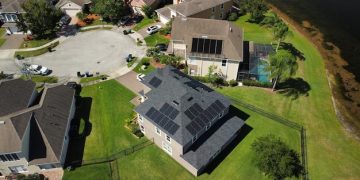Federal Solar Incentives for US Homes: What’s New?

The latest federal incentives for solar panel installation in US homes offer substantial financial benefits through tax credits, grants, and loan programs, significantly reducing the upfront costs and accelerating payback periods for homeowners embracing renewable energy.
Considering solar energy for your home is more appealing than ever, especially with the current landscape of federal support. This guide delves into what are the latest federal incentives for solar panel installation in US homes, outlining the significant financial opportunities available to homeowners.
Understanding the Investment Tax Credit (ITC)
The Investment Tax Credit (ITC), often referred to as the federal solar tax credit, stands as the most impactful federal incentive for homeowners investing in solar energy. This non-refundable tax credit directly reduces the amount of federal income tax you owe, dollar for dollar, for a percentage of the cost of your solar system. It’s not just for panels; it covers the cost of installation, labor, and even energy storage devices like batteries when installed alongside a new solar system.
Initially established by the Energy Policy Act of 2005, the ITC has been instrumental in the rapid growth of solar adoption across the United States. It has undergone various extensions and adjustments, reflecting a long-term commitment by the federal government to promote clean energy solutions. Understanding its current structure and future trajectory is crucial for any homeowner planning to go solar.
Current ITC Rates and Eligibility
- Currently at 30% through 2032: The Inflation Reduction Act (IRA) of 2022 significantly expanded the ITC, restoring it to a full 30% for systems installed between 2022 and 2032. This provides a robust incentive for nearly a decade.
- Step-down schedule: After 2032, the credit is scheduled to step down: 26% in 2033, and 22% in 2034. It is currently set to expire in 2035 for residential systems, although future legislation could alter this.
- Eligible expenses: This includes solar PV panels, labor costs for installation, necessary wiring, inverters, mounting equipment, and even energy storage equipment with a capacity of at least 3 kilowatt-hours, if installed with the solar system.
To claim the ITC, homeowners typically file IRS Form 5695, “Residential Energy Credits,” with their annual tax return. It’s important to keep meticulous records of all solar system expenses, including invoices and receipts, as these will be necessary for accurate reporting. The credit applies to the date the solar system is operational, not necessarily the purchase date. The system must also be new or being used for the first time.
The beauty of the ITC is its direct financial impact. For example, a $20,000 solar system would yield a $6,000 tax credit at the 30% rate. This directly reduces the out-of-pocket expense over time, making solar highly competitive with traditional electricity sources. Homeowners should consult with a qualified tax professional to ensure they meet all eligibility requirements and maximize their claim.
Understanding Federal Loan and Grant Programs
Beyond the direct tax credit, the federal government also offers various loan and grant programs that can further reduce the financial burden of installing solar panels. While typically not as broadly applicable or as direct for individual residential installations as the ITC, these programs often target specific demographics, geographic areas, or technological innovations, providing supplementary support.
These programs aim to make solar energy accessible to a wider range of homeowners, including those in rural areas or those with limited upfront capital. By diversifying financial incentives, the government ensures that the transition to renewable energy is equitable and widespread.
USDA Rural Energy for America Program (REAP)
While primarily aimed at agricultural producers and rural small businesses, the USDA’s REAP program can sometimes benefit rural homeowners who also conduct business from their residence. It offers grants and guaranteed loan financing for renewable energy systems, including solar. The maximum grant amount is 50% of the project cost, and the maximum loan guarantee is 75%.
The program supports projects that are commercially viable and contribute to rural economic development. Eligibility often depends on the specific nature of the home-based business and its location within a rural area as defined by the USDA. Homeowners interested in REAP should carefully review the USDA’s guidelines and seek guidance from a local USDA Rural Development office to determine their specific eligibility.
Federal Housing Administration (FHA) PowerSaver Loans
The FHA, part of the Department of Housing and Urban Development (HUD), offers mortgage insurance programs that can facilitate home energy improvements, including solar panel installations. The PowerSaver loan program specifically helps homeowners finance energy-efficient upgrades. While direct PowerSaver loans may be limited or paused in some areas, government-backed financing for energy efficiency remains a priority.
These loans are typically provided by private lenders but are insured by the FHA, reducing the risk for lenders and thus making financing more accessible. The terms and conditions vary by lender but generally aim to provide affordable financing options for energy improvements. Homeowners should inquire with FHA-approved lenders about current offerings related to energy-efficient mortgages or home improvement loans that can be used for solar.
Low-Income Home Energy Assistance Program (LIHEAP)
While LIHEAP doesn’t directly fund solar panel installations, it’s a vital federal program that assists low-income households with their energy bills. By reducing overall energy burdens, it indirectly supports the viability of energy efficiency and renewable energy initiatives for these communities. Some states and localities might use LIHEAP funds, or integrate with other programs, to explore broader energy solutions including solar.
The program is administered by states and territories, which receive block grants from the federal government and then distribute funds directly to eligible households. Understanding how LIHEAP operates in your state, and how it might potentially be combined with other energy efficiency programs, is important for low-income homeowners seeking to reduce their long-term energy costs.
It is important to note that these federal loan and grant programs require specific qualifications and application processes, which can be more complex than simply claiming the ITC. However, for homeowners who meet the criteria, they represent additional avenues for significant financial support, making solar energy even more attainable.
Exploring Other Federal Initiatives and Policies
Beyond direct financial incentives like the ITC and loan programs, the federal government supports solar adoption through various other policies and initiatives. These often aim to foster research and development, streamline regulatory processes, and promote broader market adoption, all of which indirectly benefit homeowners considering solar panel installations.
These initiatives create a supportive ecosystem for solar energy, making it more efficient, affordable, and widely available. They signal a long-term commitment to renewable energy, which provides stability and confidence for both consumers and industry stakeholders.
Net Metering Policies
While net metering policies are typically set at the state level by public utility commissions, federal frameworks and guidance often influence their development. Net metering allows homeowners with solar panels to send excess electricity generated back to the grid in exchange for credits on their utility bill. This effectively reduces electricity costs and improves the financial viability of solar systems.
Many states have adopted or are in the process of adapting net metering rules. The federal government, through entities like the Federal Energy Regulatory Commission (FERC) and the Department of Energy (DOE), promotes best practices and supports inter-state energy policies that can benefit distributed generation like rooftop solar. Homeowners should always check their state and local utility policies regarding net metering, as they can significantly impact energy savings.
Renewable Energy Research and Development

Federal funding for research and development (R&D) through agencies like the Department of Energy (DOE) is critical for advancing solar technology, making it more efficient, durable, and affordable. Investments in R&D lead to innovations in solar panel efficiency, energy storage solutions, and smart grid integration. These advancements directly translate into better and more economical solar options for consumers.
For instance, the DOE’s SunShot Initiative (now part of the Solar Energy Technologies Office) has historically aimed to reduce the cost of solar energy significantly, making it competitive with traditional energy sources without subsidies. Continuous R&D efforts ensure that future solar installations will be even more cost-effective and performant, enhancing the overall value proposition for homeowners.
Permitting and Interconnection Guidance
The federal government also plays a role in standardizing and streamlining the permitting and interconnection processes for solar installations. Long and complex permitting procedures can be a significant barrier to solar adoption. Organizations like the National Renewable Energy Laboratory (NREL) and the Solar Energy Industries Association (SEIA), often supported by federal funding, develop best practices and model ordinances for states and localities.
Efforts to simplify these processes reduce the soft costs of solar installations, which include non-hardware costs like permitting, inspection, and customer acquisition. By reducing these costs, the overall price of solar for homeowners decreases, making it a more attractive option. Advocacy and guidance from federal entities encourage states and municipalities to adopt more efficient and consistent solar permitting processes.
These broader initiatives demonstrate a multi-faceted federal approach to promoting solar energy. By investing in technology, supporting market mechanisms, and simplifying regulatory hurdles, the government helps to create an environment where residential solar becomes increasingly feasible and economically advantageous for homeowners.
Future Outlook for Federal Solar Incentives
The longevity of federal solar incentives is a critical consideration for homeowners planning to invest in solar energy. While the current landscape, bolstered by the Inflation Reduction Act (IRA) of 2022, offers a stable and attractive incentive structure for the immediate future, understanding the potential for future changes is prudent. The federal commitment to renewable energy is strong, but policy environments can evolve.
The IRA provides unprecedented long-term visibility for the solar ITC, extending the 30% credit for over a decade. This extended timeframe significantly de-risks the investment for homeowners and provides ample opportunity to plan their solar projects with confidence. However, policy adjustments based on national energy needs, economic conditions, or political priorities remain a possibility, though the current outlook is stable.
Potential for Extensions or New Programs
- Climate goals: Given the U.S.’s ambitious climate goals, it’s plausible that federal support for renewable energy, including solar, could be extended or reinforced beyond the current IRA timelines. Achievement of these goals heavily relies on widespread adoption of clean energy technologies.
- Technological advancements: As solar technology continues to evolve, new specific incentives might emerge to support innovative solutions like advanced energy storage, grid integration, or community solar models, which could benefit homeowners indirectly.
- Economic considerations: Future economic conditions could also influence policy. Should there be a need for economic stimulus or job creation, clean energy initiatives, including solar incentives, have historically been viewed as effective tools.
The current policy landscape offers a strong foundation for solar investment. However, homeowners should stay informed about legislative developments and industry trends. Engaging with solar installers and energy efficiency experts who are knowledgeable about ongoing policy changes can provide valuable insights for long-term planning.
It is important to remember that federal incentives are often designed to kickstart industries and reach a certain market penetration. As solar becomes more mainstream and cost-effective, incentives may naturally taper off or shift focus. However, the current momentum suggests a continued, albeit evolving, federal commitment to residential solar energy.
State and Local Incentives: A Layered Approach
While federal incentives like the ITC are significant, homeowners should not overlook the vast array of state and local incentives available for solar panel installation. These programs can often be stacked with federal benefits, creating a highly attractive financial package that can dramatically reduce the net cost of a solar system. Combining these layers of incentives often makes solar considerably more affordable.
State and local governments understand the importance of promoting renewable energy to meet their own energy goals, enhance grid resilience, and stimulate local economies. Therefore, they often tailor programs to meet specific regional needs and market conditions, offering a diverse landscape of support.
Common State and Local Programs

- State tax credits/rebates: Many states offer their own versions of tax credits or direct rebates that can be claimed in addition to the federal ITC. These vary widely by state, some offering a percentage of the system cost, others a fixed amount per kilowatt.
- Property tax exemptions: Several states and localities offer exemptions or abatements on property taxes for the increase in home value attributed to a solar energy system. This prevents homeowners from being taxed more simply for making an energy-efficient upgrade.
- Sales tax exemptions: Some states exempt solar energy equipment from sales tax, providing immediate savings on the purchase price of the system.
- Solar Renewable Energy Certificates (SRECs): In certain markets, homeowners can earn SRECs for the clean electricity their solar panels generate. These certificates can then be sold to utilities to help them meet state-mandated renewable energy targets, providing an ongoing revenue stream.
- Loan programs: State and local entities, sometimes in partnership with financial institutions, offer low-interest loans or specialized financing options for solar installations, making it easier for homeowners to fund their projects.
To maximize savings, homeowners should research specific incentives offered in their state, county, and even city. Websites like the Database of State Incentives for Renewables & Efficiency (DSIRE) are excellent resources for comprehensive information on state and local programs. Consulting with local solar installers can also be highly beneficial, as they are often well-versed in the specific incentives applicable to their service areas.
The combination of federal, state, and local incentives can make solar power an exceptionally sound financial decision. It’s crucial to understand how these different layers of support interact and which ones apply to your specific location and circumstances.
Navigating the Installation Process and Maximizing Benefits
Once you are aware of the incredible array of federal, state, and local incentives, the next step is to navigate the actual installation process efficiently to ensure you maximize these benefits. Strategic planning, careful contractor selection, and diligent record-keeping are key to a smooth transition to solar energy and to fully realizing your financial advantages.
The installation process typically involves several stages, from initial assessment to system activation. Understanding each step and ensuring compliance with all requirements for incentive eligibility will lead to a successful and economically rewarding solar investment.
Key Steps and Considerations
- Research and quotes: Obtain multiple quotes from reputable solar installers. Ensure these quotes detail all costs, system size, estimated energy production, and the specific equipment being used. Discuss how federal and local incentives are factored into their pricing.
- Contractor due diligence: Verify installers’ licenses, insurance, and customer reviews. A good installer will be knowledgeable about all applicable incentives and can guide you through the process of claiming them.
- Permitting and interconnection: Your installer will typically handle the complex permitting process with your local jurisdiction and the interconnection agreement with your utility company. It’s crucial that these steps comply with all technical standards to ensure eligibility for incentives and to connect safely to the grid.
- System installation and inspection: Once installed, the system will undergo inspections by local authorities and your utility company before being granted permission to operate. This “permission to operate” (PTO) date is often critical for ITC eligibility.
Maximizing benefits also involves understanding your personal tax situation. The federal ITC is a tax credit, meaning it reduces your tax liability. If your tax liability is less than the credit amount in a given year, you can typically carry forward the unused portion of the credit to subsequent tax years. This carry-forward provision ensures that even if you don’t have enough tax liability to use the full credit in one year, you won’t lose it.
Finally, always keep thorough documentation. This includes contracts, invoices, proof of payment, system specifications, and any correspondence related to permits or utility interconnections. These records are vital for claiming tax credits and for any future dealings related to your solar system. By approaching the installation process methodically and with an eye on all available incentives, homeowners can confidently embark on their solar journey.
Consumer Protection and Avoiding Pitfalls
As the solar industry grows and federal incentives remain attractive, it’s crucial for homeowners to be vigilant and informed to protect themselves from potential pitfalls. While most solar companies are reputable, some unethical practices can emerge. Understanding how to identify these and knowing your rights as a consumer can save you time, money, and frustration.
The key to a successful solar journey lies not just in finding the right incentives but also in choosing the right partners and being aware of common red flags. Consumer protection agencies, industry standards, and federal guidelines are in place to safeguard homeowners during this process.
Tips for Consumer Protection
- Beware of pushy sales tactics: High-pressure sales or “limited-time offers” that demand immediate decisions should raise a red flag. Reputable companies provide clear information and allow time for informed choices.
- Understand the contract thoroughly: Read every detail of the contract before signing. Pay close attention to financing terms, warranty information, installation timelines, and what happens if the system underperforms. Don’t sign anything you don’t fully understand.
- Verify claims about savings and incentives: Ensure any promised energy savings or incentive amounts are realistic and clearly documented. Request written estimates and detailed explanations of how these figures are calculated. Be wary of installers who make guarantees about federal tax credits or state programs without qualifying conditions.
- Check credentials and reviews: Confirm the installer has the necessary licenses and certifications. Check their reputation through independent review sites, the Better Business Bureau, and local consumer protection agencies.
- Know your rights: Familiarize yourself with your state’s rescission period (cooling-off period) for home improvement contracts, allowing you to cancel within a certain timeframe without penalty.
The Department of Energy and the Federal Trade Commission (FTC) provide resources for consumers considering solar energy, offering guidance on what to expect and how to avoid scams. They often advise getting multiple quotes, understanding financing options (loan, lease, PPA, or cash purchase), and being wary of unsolicited offers.
By conducting thorough due diligence and being an informed consumer, homeowners can confidently navigate the solar market. This proactive approach ensures that the benefits from federal incentives for solar panel installation in US homes are fully realized, leading to sustainable energy savings and a positive environmental impact.
| Key Incentive | Brief Description |
|---|---|
| ☀️ Investment Tax Credit (ITC) | 30% federal tax credit for residential solar systems installed through 2032. |
| 🌾 USDA REAP & FHA Loans | Rural energy grants/loans and FHA-insured financing for energy improvements. |
| ⚙️ R&D & Permitting | Federal efforts to advance solar tech and streamline installation processes. |
| 🌎 State & Local Programs | Additional tax credits, rebates, SRECs, and property/sales tax exemptions. |
Frequently Asked Questions About Federal Solar Incentives
The current federal solar tax credit, known as the Investment Tax Credit (ITC), is at 30% for solar systems installed between 2022 and 2032. This was re-established and extended by the Inflation Reduction Act of 2022, offering significant savings for homeowners choosing solar.
Yes, the federal Investment Tax Credit (ITC) does cover the cost of energy storage equipment, such as batteries, provided they have a capacity of at least 3 kilowatt-hours (kWh) and are installed in connection with a new solar system. This inclusion further enhances the financial viability of solar-plus-storage solutions.
No, the federal Investment Tax Credit (ITC) is only available to homeowners who purchase their solar panel system outright or finance it with a loan. If you lease your solar panels or enter into a Power Purchase Agreement (PPA), the tax credit is typically claimed by the system owner (the leasing company), not the homeowner.
While the primary federal incentive, the ITC, directly benefits those with tax liability, some federal programs like the USDA Rural Energy for America Program (REAP) indirectly assist specific low-income or rural populations. Additionally, the Low-Income Home Energy Assistance Program (LIHEAP) supports energy costs, and some states integrate federal funds into programs for low-income solar adoption.
State and local incentives typically stack on top of federal incentives, meaning you can claim both at the same time. This layered approach significantly enhances the overall financial benefits of installing solar panels, often making the investment highly attractive. Always check your specific state and local programs for the most accurate information.
Conclusion
The landscape of federal incentives for solar panel installation in US homes presents an exceptionally opportune moment for homeowners to embrace renewable energy. Driven primarily by the robust Investment Tax Credit of 30%, complemented by various loan programs, research initiatives, and supportive policies, the financial viability of solar has never been stronger. When combined with a multitude of state and local incentives, the cumulative savings can make solar ownership a highly compelling and responsible investment for the long term. As a journalist observing these trends, it’s clear that the federal government’s enduring commitment to clean energy, solidified by recent legislative actions, provides a stable and encouraging environment for widespread solar adoption. For any homeowner considering this transition, thorough research and proactive engagement with reputable professionals will undoubtedly unlock the full spectrum of benefits available.





